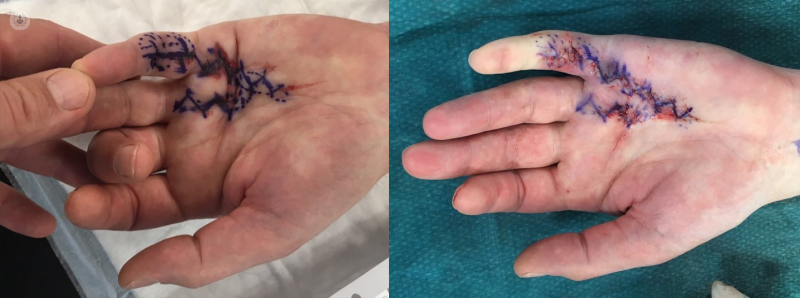WALANT: wide-awake hand surgery. Why is it done?
Escrito por:WALANT hand surgery, which stands for Wide Awake Local Anaesthetic No Tourniquet, is a totally different approach to surgery which allows patients to undergo hand surgery whilst wide-awake. Mr Ian Grant, a plastic surgeon based in Cambridge, explains to our readers what the advantages to having this procedure are in comparison to one involving general anaesthetic.
What are the advantages to the patient of WALANT hand surgery?
The technique avoids the need for general anaesthetic so the patient is wide-awake during surgery. WALANT patients also do not need to be starved on the day of surgery. By carrying out surgery with the patient wide awake, the stay in hospital before and after surgery is shorter. Patients can talk to the surgeon during the operation and can see the immediate effect of surgery.
For some operations the ability of a patient to move his or her fingers during the procedure can be extremely helpful. The patient is usually completely pain-free for several hours after surgery and the overall feedback from patients undergoing WALANT hand surgery is excellent.
How does it work?
A mixture of local anaesthetic and very dilute adrenalin is injected into the hand about ten minutes before the start of surgery. This is done carefully and slowly, using a very fine needle to minimize the discomfort.
In conventional general anaesthetic hand-surgery, a tourniquet is applied to the upper arm to prevent blood flowing into the hand during the operation. In WALANT hand-surgery, the small amount of adrenalin in the local anaesthetic solution produces vasoconstriction (temporary closure of the fine blood vessels) in the hand which allows the operation to be performed without the need for a tourniquet.

Left: A patient with Dupuytren’s disease with a curled and bent small finger immediately before surgery. The planned incisions are marked in blue, the cords of fibrotic diseased tissue responsible for this condition lie below the areas of skin marked with dotted lines.
Right: The same patient immediately after WALANT hand surgery. He was awake throughout the procedure: no tourniquet was used. The fibrotic cords were removed, the skin was closed and the patient was able to immediately see how flat his hand was. I was able to discuss how quickly he could return to work and talk him through some helpful exercises whilst carrying out his surgery.
Are there other advantages?
By avoiding the need for general anaesthetic fewer people are required in the operating theatre. The anaesthetist and nursing support staff are no longer needed which therefore represents a huge saving in time and money.
In addition to an economic benefit, WALANT hand surgery has an environmental benefit. At the end of any general anaesthetic operation numerous items of plastic equipment are discarded (usually they are incinerated). Wide-awake surgery uses fewer pieces of equipment, which produces less waste, saves money and is good news for the environment.
What are the challenges of WALANT hand surgery?
This is a comparatively new approach to hand surgery, so surgeons and theatre staff have to adapt to the presence of an awake patient. The technique requires the slow and careful administration of local anaesthetic before the start of surgery and requires the surgeon to cauterise blood vessels within the surgical wound as she or he progresses with the operation. Once the team has adapted to this rather different approach, it can be hugely rewarding to be able to demonstrate the effects of the operation immediately to an awake patient, and to discuss the aftercare during the procedure.
What procedures are suitable for WALANT hand surgery?
The range of procedures suitable for this technique is dependent upon the experience and enthusiasm of the surgeon and clinic or hospital. I have been using this technique for the last year for procedures that include: trigger finger release, carpal tunnel release, Dupuytren’s contracture surgery, finger fractures, thumb ligament rupture, thumb base surgery for arthritis, tendon repairs, and tendon transfers.
To make an appointment with Mr Ian Grant, visit his profile on our website and book online.


